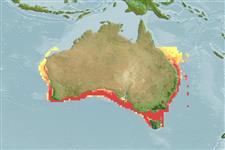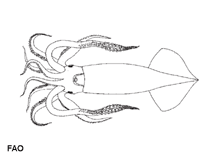Nototodarus gouldi (McCoy, 1888)
Gould's flying squid| Native range | All suitable habitat | Point map | Year 2050 |

|
| This map was computer-generated and has not yet been reviewed. |
| Nototodarus gouldi AquaMaps Data sources: GBIF OBIS |
Classification / Names Common names | Synonyms | CoL | ITIS | WoRMS
Cephalopoda | Oegopsida | Ommastrephidae | Todarodinae
Environment: milieu / climate zone / depth range / distribution range Ecology
Pelagic-oceanic; depth range 0 - 700 m (Ref. 275), usually 50 - 300 m (Ref. 8121). Subtropical; 19°S - 43°S, 109°E - 157°E (Ref. 275)
Distribution Countries | FAO areas | Ecosystems | Occurrences | Introductions
Indo-West Pacific: Australia and New Zealand. Subtropical to temperate.
Length at first maturity / Size / Weight / Age
Maturity: Lm ? range ? - ? cm Max length : 35.0 cm ML male/unsexed; (Ref. 275); 40 cm ML (female); max. published weight: 800.00 g (Ref. 275)
Females grow larger than males (Ref. 3722). Maximum depth from Ref. 8121. Minimum common depth from Ref. 121690. Neritic and oceanic species (Ref. 121690). Mostly inhabits waters <500 m in depth on the continental shelf and slope (Ref. 121690). Common in the continental shelf and sometimes can even enter shallow waters and estuaries, particularly during summer (Ref. 121673). Most abundant near the shelf-break front or where other mesoscale oceanographic activity is present. Mature squid may be restricted to deeper offshore waters for successful spawning (Ref. 121689). Feeds on ommastrephid squids, fishes (primarily pilchards; Ref. 275).
Life cycle and mating behavior Maturity | Reproduction | Spawning | Eggs | Fecundity | Larvae
Members of the class Cephalopoda are gonochoric. Male and female adults usually die shortly after spawning and brooding, respectively. Mating behavior: Males perform various displays to attract potential females for copulation. During copulation, male grasp the female and inserts the hectocotylus into the female's mantle cavity where fertilization usually occurs. Life cycle: Embryos hatch into planktonic stage and live for some time before they grow larger and take up a benthic existence as adults.
Main reference
References | Coordinator | Collaborators
Roper, C.F.E., M.J. Sweeney and C.E. Nauen. 1984. (Ref. 275)
IUCN Red List Status (Ref. 130435)
Least Concern (LC) ; Date assessed: 05 May 2010
CITES status (Ref. 108899)
Not Evaluated
CMS (Ref. 116361)
Not Evaluated
Threat to humans
Human uses
Fisheries: commercial
| FishSource |
Tools
More information
Age/Size
Growth
Length-weight
Length-length
Morphology
Larvae
Abundance
Growth
Length-weight
Length-length
Morphology
Larvae
Abundance
Internet sources
BHL | BOLD Systems | CISTI | DiscoverLife | FAO(Publication : search) | Fishipedia | GenBank (genome, nucleotide) | GloBI | Gomexsi | Google Books | Google Scholar | Google | PubMed | Tree of Life | Wikipedia (Go, Search) | Zoological Record
Estimates based on models
Preferred temperature
(Ref. 115969): 13.7 - 21.2, mean 15.9 (based on 106 cells).



